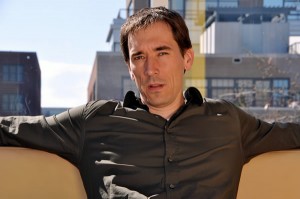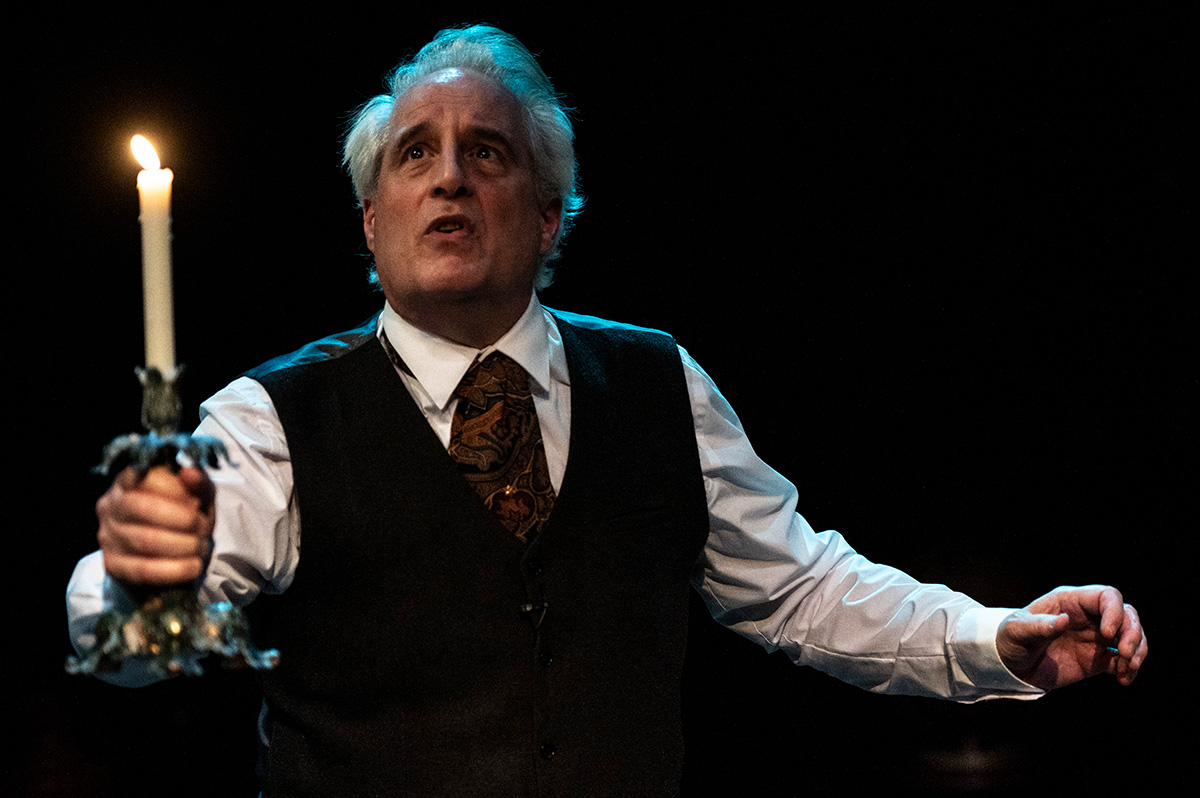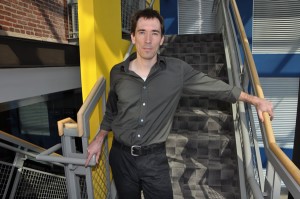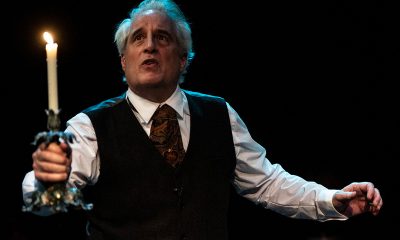Theater
Studio’s Muse
New artistic director first to succeed founder Zinoman


David Muse, the new artistic director of the Studio Theatre. (Washington Blade photo by Michael Key)
He has been labeled a “wunderkind,” but no one would mistake this young man who has taken the helm of the Studio Theatre as a “wild child,” a Rimbaud on the rampage, scary, impudent, a feral genius in a state of artistic nature.
For with David Muse, who became at age 36 Studio’s second artistic director when founder Joy Zinoman passed him the reins last September, the clearest impression is of a young man with artistic time and motion studies on his mind, with a bookkeeper’s talent for cutting costs or adding a new line to the budget — either way, it’s the temperament of a manager.
But that would be the wrong impression also.
The best explanation about what makes David Muse run — as an artist himself, Yale-educated twice over, as well as the new manager of Studio Theatre — may come from Zinoman, who says, “David’s story is the classic, American story of a smart, talented kid from a small town who finds his passion, pursues it with dedication and intensity, and manages to win friends and admirers by virtue of his charm, sensitivity and intelligence.”
She has also said of the preternaturally calm and highly cerebral Muse, a vegan, a cyclist and a fitness buff, that “he’s very seductive and charming,” and Susan Butler, Studio’s board chairman, told the Washington Post that “I hope he likes to raise money.” That’s a handy charm in that rarefied realm of courting wealthy patrons, coaxing those birds from their tall trees and out of their mansions, just another talent for Muse to demonstrate.
Muse must use persuasion to find new patrons just as he has also found old patrons, key sponsors like Zinoman of course but also Michael Kahn at the Shakespeare Theatre Company who plucked Muse from New York City to return to Washington in 2004 to become his artistic aide-de-camp. His talent is in having talent and in inspiring others more senior also with talent to appreciate and invest in his own talent. Which is sizable.
Consider that he has amassed a glittering resume as a director — including staging an all-male version of “Romeo and Juliet” — since arriving in D.C. in 1996 to teach calculus to kids at Eastern High School, when he was soon drawn to theater at Studio’s own acting conservatory, where first he was a student and then began to dabble part-time as a “juvenile,” the theatrical term for a male newcomer, enchanted by the stage, focusing on acting at the beginning, one time even dressing as an ostrich in size-13 high heels. He later tackled directing also.
Today he is filling even bigger shoes, succeeding the trail-blazing Zinoman in command of about 60 staff in four stages seating 900 in three buildings with about 60,000 square feet set in the heart of D.C.’s Logan Circle neighborhood, anchoring in a former auto showroom at 14th and P Streets. With its more than $5 million annual budget, Studio is a major force on the local theater scene, mounting major productions every year and with its new and impressive 2011-2012 season just announced. And of course he is also in charge, with Joy Zinoman still as its lead faculty member, of the Studio Theatre Acting Company, where his serious career in theater began.
Born in Appleton, Wis., he spent most of his childhood in Fulton, Mo., a small town (11,000). In high school he threw himself into theater and graduated valedictorian. In 1992 he left Fulton, the first student from his high school to attend an Ivy League school, for New Haven and Yale University where he studied ethics, politics and economics. Upon graduation, Muse joined Teach for America and headed for D.C., teaching math and also leading Outward Bound wilderness programs for troubled youths during the summer. But he also found his way to Studio’s acting school, to hone his passion for drama, and in 2000 he returned to Yale, this time to its drama school, to earn a master’s in directing.
Next he moved to New York City, but then he soon came back to D.C. when summoned by Kahn to become his second in command as associate artistic director at the Shakespeare Theatre Company, where he helped grow the company from its single theater at the Lansburgh with the addition of the new Harman Hall. He also was primary liaison for all the talent. He also began to direct plays at Studio’s smaller and edgier 2nd Stage.
The next year, 2006, also at Studio, he directed Bryony Lavery’s critically lauded “Frozen.” Then, last year, while also directing an electrifying version of Neil LaBute’s “Reasons To Be Pretty” there, he also threw his hat into the ring to replace Zinoman. After a scrupulous nationwide search lasting a year, he pulled that rabbit from out of that hat, emerging from half a dozen finalists to step into her shoes there officially last September.
Asked about his artistic vision, he demures at first, saying that he finds it “challenging to say the least” to define such an overview “when the work here is so purposefully eclectic, with so broad a range of theatrical offerings.” He also offers what he calls “another disclaimer” to having any “broad vision,” in that “you need to leave room,” he insists, for the thespian Holy Spirit, “for what feels right, this year, or at any other moment.”
Besides, Muse says, Studio “is not a place that needed someone to come in, to save or reinvent it.” But that said, he has even so his own vision of course, which is why in addition to his managerial mindset he was chosen for this job.
“The challenge,” he says, is “to balance all the historic strengths of this place with some new energy, and that’s what I aim to do.”
Those strengths, he says, include that it stages what he rightly boasts are “plays of real literary and theatrical merit.” He intends, he says, to build on that Studio strong deck of cards by pulling out some new ones — by “going in a little less familiar direction,” in part by bringing in more international productions but especially by “working with living writers, and working with them on the creation of new work,” not generally seen as a strong card at Studio in the past.
“We want to welcome these writers into the building as active collaborators,” he says, pointing to two world premieres slated for Studio in its just-announced 2011-2012 season.
This year, meanwhile, has included a season of superb performances in productions like the gay-themed “Marcus; or the Science of Sweet” (though Muse is straight and has a girlfriend), a season that has been the result of his collaboration with Zinoman, which will also later feature Anna K. Jacob’s “Pop!” a new musical about Andy Warhol. Muses also draws attention to “The History of Kisses,” set for this summer as an example of collaboration with its author, David Cale, someone Muse calls “an electrifying solo performer, returning to D.C. after a long history here, but having been away for about 10 years.”
But it is with next year’s slate of 11 offerings that Muse lets his own muse come to the fore. First out of the gate, Sept. 7-Oct. 16, comes a new play in its U.S. premiere, directed by Muse, “The Habit of Art,” by Alan Bennett, the English author of “The History Boys,” whose career began decades ago as a member of the Oxford-Cambridge troupe of performers, “Beyond The Fringe.”
Starring the great D.C. actor Ted van Griethuysen as the gay poet W.H. Auden, it is set deep in the bowels of London’s National Theatre as rehearsals for a new play go on and the famed composer Benjamin Britten, also gay, and Auden’s former lover, now troubled at work on a new opera, seeks out the poet after a 25-year separation, to collaborate again, this time artistically. Between visits by Auden’s rent-boy and a biographer — briefly mistaken for the rent-boy — these two aging artists must wrestle with long-buried desire and current jealousy and seek to understand all the reasons their erstwhile friendship fell apart.
Called both wistful and “filthily funny,” the play is what Muse calls “an imaginary meeting” between the two great artists, when after a quarter century Auden comes to talk about collaborating again, but the rent-boy keeps returning” as the play progresses.
Looking to the new season, Muse also points to two world premieres — one in the Lab Series Sept. 28-Oct. 16 — “Lungs,” by Duncan Macmillan,” the chamber drama of a couple trying to face their future in a time of global anxiety over terrorism and erratic weather. The other world premiere comes next February and March in Studio’s 2nd Stage, in a new play, “Astro Boy and the God of Comics,” by Georgetown University theater professor Natsu Onoda Power, who also directs.
Muse says she has been invited to come to Studio “to conceive of this new play” there. It takes on Japanese Manga in a highly visual performance that he calls “a retro and sci-fi, multi-media extravaganza” about the 1960s animation series “Astro Boy,” a crime-fighting boy robot, and the life of his creator Osamu Tezuka.
Another play, set for November-December, is written and performed by former “Daily Show” correspondent Lauren Weedman, who has been called “a female Robin Williams.” This one-woman show, “Bust” is based on her experiences working as a volunteer advocate in a Southern California prison for women. In her solo performance she plays dozens of characters, switching from prostitute to parole officer, addict to editor with what Muse calls “nuance and empathy.”
Other plays will also startle and stir audiences, he predicts, including “The Golden Dragon” by German playwright Roland Schimmelpfennig, in its U.S. premiere in November-December. Called both “poetic” and “brutal,” it is set in the cramped kitchen of an Asian restaurant where four cooks pull the tooth of a Chinese co-worker. His tooth ends up in the Thai soup of a flight attendant, and that’s just the beginning of unexpected linkages connected to the young Chinese man sans tooth. Muse calls it “fierce and vicious” but also “a kaleidoscopic look at a globalized world,” where five actors “cross age, race and gender” to play 15 characters showing “how intertwined our lives really are.”
Also certain to draw attention, Muse predicts, will be another of the 2nd Stage productions, coming in the summer of 2012, “Bloody Bloody Andrew Jackson,” by Alex Timbers, with music and lyrics by Michael Friedman.
“American history has never been this sexy,” Muse says, “in this rowdy and irreverent musical,” a scathing satire that re-imagines President Andrew “Old Hickory” Jackson as a rock star.
Theater
Out actor talks lead role in ‘Fiddler on the Roof’
Signature Theatre production runs through Jan. 25

‘Fiddler on the Roof’
Through Jan. 25
Signature Theatre
4200 Campbell Ave.
Arlington, Va.
Tickets start at $47
Sigtheatre.org
Out actor Ariel Neydavoud is deep into a three-month run playing revolutionary student Perchick in the beloved 1964 musical “Fiddler on the Roof” at Signature Theatre in Arlington. And like his previous gigs, it’s been a learning experience.
This time, he’s gleaning knowledge from celebrated gay actor Douglas Sills who’s starring as the show’s central character Tevya, a poor Jewish milkman in the fictional village of Anatevka in tsarist Russia circa 1905.
In addition to anti-Semitism and expulsion, Tevya is struggling with waning traditions in a changing world where his daughters dare suggest marrying for love. Daughter Hodel (Lily Burka) falls for Perchick, an outsider who comes to town brandishing new ideas.
And along with its compelling and humor filled storyline, “Fiddler” boasts iconic numbers like “If I Were a Rich Man,” “Tradition,” “Matchmaker, Matchmaker,” and “Sunrise, Sunset.”
Neydavoud, born and raised as an only child in the West Los Angeles neighborhood lightheartedly referred to as Tehrangeles (due to the large Iranian-American population), has always been passionate about performing. “It’s like I came out of the womb tap dancing,” he says. Fortunately, his mother, an accomplished pianist and composer, served as built-in accompanist.
He began acting and singing at kid camps and a private Jewish middle school alongside classmate Ben Platt. In his teens, Neydavoud spent three glorious weeks at Stagedoor Manor, a well-known theater camp in Upstate New York, where he solidified his desire to pursue theater as a profession, and started to feel comfortable with being queer.
Following high school, he studied at AMDA (American Musical and Dramatic Academy) and soon after morphed from theater student to professional actor.
WASHINGTON BLADE: Your entry into showbiz seems to have been a smooth one.
ARIEL NEYDAVOUD: I’m happy to hear it seems that way. I’d rarely describe anything about this profession as smooth; nonetheless, what I love about this work is that it gives opportunities to have so many new experiences: new shows, new parts, and new communities who come together in a moment’s notice purely for the sake of creating art.
BLADE: Tell us about Perchick.
NEYDAVOUD: He comes to Anatevka and challenges their ideals and way of life. That’s something I can relate to.
I’m Jewish on both sides, but I’m also queer, first generation American, [his mother and father are from Germany and Iran, respectively], and a person of color. I never feel like I belong to a single community. That’s what has emboldened my inner activist to speak up and challenge ideas that I don’t necessarily buy into.
BLADE: You sing beautifully. Perchick’s song is “Now I have Everything,” an Act II melody about finding love. Was it an instant fit for you?
NEYDAVOUD: Not instantly.I’m traditionally a first tenor. Perchick is baritone range, a little outside of my comfort zone. After being cast, I asked our director Joe Calarco if he would be comfortable raising the key, something they did with the recent Broadway revival. He was firm about not doing that.
As an artist I see challenges as opportunities to grow, so it’s been really good exploring my lower register.
BLADE: Audiences have commented on an intimacy surrounding this production.
TK: It’s performed in the round with a dining table at its center. It could be a sabbath or seder table, however you interpret it, but I find it a brilliant way to illustrate community and tradition.
It feels like the audience is invited to the table and join the residents of Anatevka. The show’s moments of joy like the betrothal song “To Life (L’Chaim)” are intensified, and conversely the pogrom scenes are made more difficult. It feels like we’re sharing space.
BLADE: Do your encompassing identities broaden casting possibilities for you?
NEYDAVOUD: Marketing yourself as ethnically ambiguous can be a helpful tool. After “Hamilton” and the pandemic there was more of a shift toward authenticity. I try to steer toward playing Middle Eastern, Southwest Asian, Jewish, and mixed-race characters without being too prescriptive.
BLADE: Tell us your dream roles?
NEYDAVOUD: I’d love to play the Emcee in Cabaret [often portrayed as a gender-fluid, queer-coded, or non-binary figure]. And I’d like to direct a production of “Godspell” with a fully Middle Eastern cast. I think portraying Jesus and disciples in Middle Eastern bodies as Bohemian idealists living under an oppressive regime could be especially impactful.
BLADE: Can today’s queer audiences relate to life on the shtetl?
NEYDAVOUD: As a piece, “Fiddler” is timeless. Beyond the magical score, it hits home with just about anyone who’s ever felt othered. There are relevant themes of displacement and persecution, and maintaining cultural identity in the wake of turbulence, all ideas that tend to resonate with queer people.
Theater
Studio’s ‘Mother Play’ draws from lesbian playwright’s past
A poignant memory piece laced with sadness and wry laughs

‘The Mother Play’
Through Jan. 4
Studio Theatre
1501 14th St., N.W.
$42 – $112
Studiotheatre.org
“The Mother Play” isn’t the first work by Pulitzer Prize-winning lesbian playwright Paula Vogel that draws from her past. It’s just the most recent.
Currently enjoying an extended run at Studio Theatre, “The Mother Play,” (also known as “The Mother Play: A Play in Five Evictions,” or more simply, “Mother Play”) is a 90-minute powerful and poignant memory piece laced with sadness and wry laughs.
The mother in question is Phyllis Herman (played exquisitely by Kate Eastwood Norris), a divorced government secretary bringing up two children under difficult circumstances. When we meet them it’s 1964 and the family is living in a depressing subterranean apartment adjacent to the building’s trash room.
Phyllis isn’t exactly cut out for single motherhood; an alcoholic chain-smoker with two gay offspring, Carl and Martha, both in their early teens, she seems beyond her depth.
In spite (or because of) the challenges, things are never dull in the Herman home. Phyllis is warring with landlords, drinking, or involved in some other domestic intrigue. At the same time, Carl is glued to books by authors like Jane Austen, and queer novelist Lytton Strachey, while Martha is charged with topping off mother’s drinks, not a mean feat.
Despite having an emotionally and physically withholding parent, adolescent Martha is finding her way. Fortunately, she has nurturing older brother Carl (the excellent Stanley Bahorek) who introduces her to queer classics like “The Well of Loneliness” by Radclyffe Hall, and encourages Martha to pursue lofty learning goals.
Zoe Mann’s Martha is just how you might imagine the young Vogel – bright, searching, and a tad awkward.
As the play moves through the decades, Martha becomes an increasingly confident young lesbian before sliding comfortably into early middle age. Over time, her attitude toward her mother becomes more sympathetic. It’s a convincing and pleasing performance.
Phyllis is big on appearances, mainly her own. She has good taste and a sharp eye for thrift store and Goodwill finds including Chanel or a Von Furstenberg wrap dress (which looks smashing on Eastwood Norris, by the way), crowned with the blonde wig of the moment.
Time and place figure heavily into Vogel’s play. The setting is specific: “A series of apartments in Prince George’s and Montgomery County from 1964 to the 21st century, from subbasement custodial units that would now be Section 8 housing to 3-bedroom units.”
Krit Robinson’s cunning set allows for quick costume and prop changes as decades seamlessly move from one to the next. And if by magic, projection designer Shawn Boyle periodically covers the walls with scurrying roaches, a persistent problem for these renters.
Margot Bordelon directs with sensitivity and nuance. Her take on Vogel’s tragicomedy hits all the marks.
Near the play’s end, there’s a scene sometimes referred to as “The Phyllis Ballet.” Here, mother sits onstage silently in front of her dressing table mirror. She is removed of artifice and oozes a mixture of vulnerability but not without some strength. It’s longish for a wordless scene, but Bordelon has paced it perfectly.
When Martha arranges a night of family fun with mom and now out and proud brother at Lost and Found (the legendary D.C. gay disco), the plan backfires spectacularly. Not long after, Phyllis’ desire for outside approval resurfaces tenfold, evidenced by extreme discomfort when Carl, her favorite child, becomes visibly ill with HIV/AIDS symptoms.
Other semi-autobiographical plays from the DMV native’s oeuvre include “The Baltimore Waltz,” a darkly funny, yet moving piece written in memory of her brother (Carl Vogel), who died of AIDS in 1988. The playwright additionally wrote “How I Learned to Drive,” an acclaimed play heavily inspired by her own experiences with sexual abuse as a teenager.
“The Mother Play” made its debut on Broadway in 2024, featuring Jessica Lange in the eponymous role, earning her a Tony Award nomination.
Like other real-life matriarch inspired characters (Mary Tyrone, Amanda Wingfield, Violet Weston to name a few) Phyllis Herman seems poised to join that pantheon of complicated, women.
Theater
D.C. theater scene has something for everyone this holiday season
‘Nutcracker,’ ‘A Christmas Carol,’ and much more

With its familiar music, yuletide imagery, and storytelling, theater can be a big part of the holidays. Add to that making memories and theater tickets wrapped as presents under the tree, and it’s a seasonal no brainer.
Folger Theatre presents “Resplendent Joy: Christmas Traditions from Spain and Portugal” (Dec. 5-14); the marvelous Folger Consort will perform early Spanish Christmas carols and traditional holiday music from early modern Spain and Portugal: folger.edu/resplendent
At Round House Theatre, playwright Sam Holcroft’s “Rules for Living” (Dec. 3-Jan. 4) makes its U.S. premiere. The darkly funny holiday comedy was a hit in London and is now hoping to repeat that success with a version tailored for the states. The seven-person cast includes versatile actors Naomi Jacobson and real-life spouse John Lescault. Ryan Rillette directs. roundhousetheatre.org
Theatre J presents “Chanukah in the Dark” (Dec. 6-21), an hour-long play ideal for ages five and up. “When the lights go out during Chanukah, Max and family begin sharing songs, stories, and traditions — only to discover the lights they needed and the miracles they searched for were in their midst all along.” edcjcc.org
The Cathedral Choral Society’s “Joy of Christmas” (Dec. 13-14) presents a wonderful program of carols and beloved holiday favorites at the festively decorated National Cathedral. The program features Seraph Brass, organist Edward Hewes, Carillonneur Edward M. Nassor, percussionist Mary La Blanc of “The President’s Own” U.S. Marine Band, and the Eastern Concert Choir from Eastern Senior High School. Cathedralchoralsociety.org
With “The Holiday Show,” (Dec. 13, 14, and 20), the Gay Men’s Chorus returns to entertain audiences with its annual and most popular show.
This year the holiday extravaganza is bigger than ever at historic Lincoln Theatre with new, soulful arrangements of favorite holiday carols: “The reindeer will be high-kicking and the snowflakes will sparkle. Songs include “O Holy Night,” “Rudolph the Red Nosed Reindeer,” “Let It Snow,” “We Wish You the Merriest,” and “Go Tell It on the Mountain.’” gmcw.org
At Olney’s intimate Mulitz-Gudelsky Theatre Lab, out actor Michael Russotto is back for the holiday season in his solo show “Christmas Carol: A Ghost Story of Christmas” (through Dec. 28). The talented Russotto portrays nearly 50 different characters from the Charles Dickens classic, that proves “funnier and far more relevant than you might imagine.” Olneytheatre.org
Also on holiday offer in the DMV are a jolly bunch of musical chestnuts as well as reliable Christmas crowd-pleasers.
Included on the roster is Olney Theatre’s production of Jerry Herman’s “Hello, Dolly!” (through Jan. 4) starring the mega-talented Nova Y. Payton. Based on the play “The Matchmaker” by famed gay playwright Thornton Wilder, the musical has proved a vehicle for many a diva including Carol Channing, Pearl Bailey, Bette Midler, and Barbra Streisand. Now Payton dons the mantle and the buzz is good.
Another beloved musical is “Fiddler on the Roof” (through Jan. 25), the story of Tevye, a poor Jewish milkman, his family and their tight-knit community who honor tradition while contending with pogroms in Czarist Russia. Currently being performed intimately in the round at Signature Theatre in Arlington and directed by Joe Calarco, the large cast features actors Douglas Sills, Chrisopher Bloch, and terrific out actor Jake Loewenthal as the poor tailor Motel Kamzoil, all singing Broadway favorites like “Sunrise, Sunset” “If I Were a Rich Man” and “Matchmaker.” sigtheatre.org
At Shakespeare Theatre Company’s Harman Hall is Frank Loesser’s “Guys and Dolls” (through Jan. 4). Based on tales from famed American journalist Damon Runyon, the show focuses on two overlapping love stories set in Depression-era Times Square. The terrific score includes songs like “Luck Be a Lady,” “Sit Down, You’re Rockin’ the Boat,” “A Bushel and a Peck,” and more songs you’ll know. Directed by Francesca Zambello and choreographed by Joshua Bergasse.
The cast includes Julie Benko, Lamont Brown, and Holly Twyford as General Matilda B. Cartwright, which is reason enough to buy a ticket. shakespearetheatre.org
And for hardcore traditionalists there’s the Washington Ballet’s “The Nutcracker” (through Dec. 29) with its balletic magic at the charming gilded Warner Theatre. The beloved production of Tchaikovsky’s ballet, here set in 1882 Georgetown, features a retinue of agile partiers, children, soldiers, rats, and notable figures from American history. washingtonballet.org
And last but hardly least, historic Ford’s Theatre presents “A Christmas Carol” (through Dec. 31), an enduring Washington tradition since I was youngish. Conceived by Michael Baron, this charming Dickens’ moneymaker again spotlights Craig Wallace as miserly Ebenezer Scrooge who after a night of ghostly visits, rediscovers Christmas joy. Fords.org





















